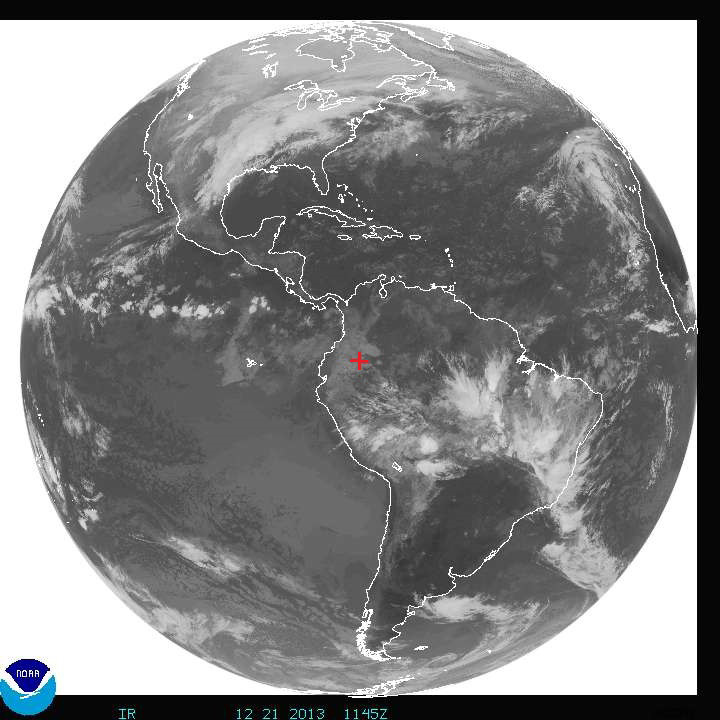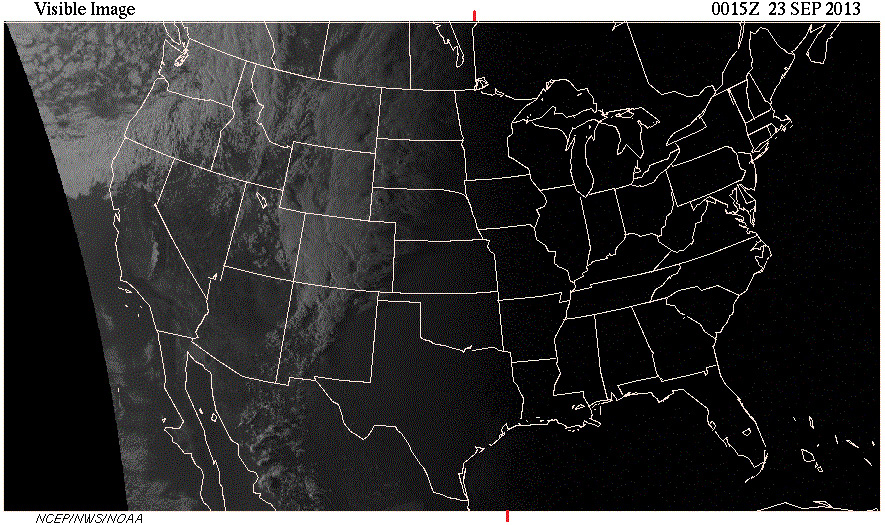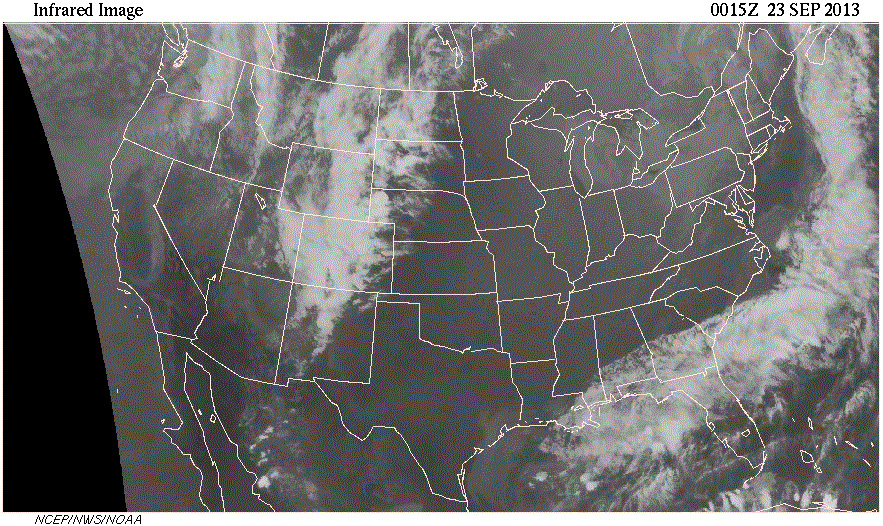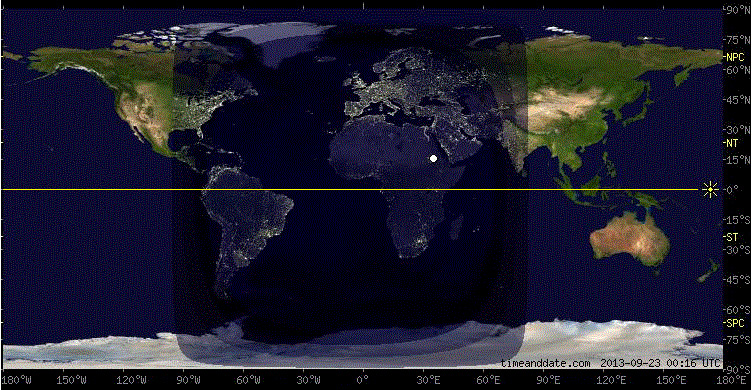
WEATHER SATELLITE IMAGERY
Objectives:
Satellites are orbiting platforms with sensors that make it possible for us to “look” down on Earth’s surfaces and its overlying atmosphere. The views from space of those broad expanses show that fair and stormy weather are somehow related. The giant whirls of clouds and clear areas blend from one to another within the canopy of air that thinly envelops the planet. A sequence of views of weather systems displays their evolution, rotations, and advances across Earth’s surface. With the satellite views, areas showing signs of potential or actual hazardous weather conditions can be carefully monitored.
Satellite images are produced by sunlight that is reflected (and scattered) by the Earth-atmosphere system and by radiation that is emitted by that same system.
After completing this investigation, you should be able to:
- Distinguish among the different types of weather-satellite imagery and describe the information they can provide.
- Interpret probable atmospheric conditions from weather-satellite imagery.
Introduction:
The accompanying images in Figure 1 were acquired simultaneously from sensors aboard an Earth geostationary satellite (GOES East) in orbit about 36,000 km (22,300 mi) above a spot on the equator at 75 degrees west longitude. They were acquired on 21 December 2013 at 1145Z. (The Northern Hemisphere’s winter solstice occurred at 1711Z that day.) A geostationary satellite orbits counterclockwise (as viewed from above Earth’s North Pole) at the same angular rate as Earth rotates eastward so that the satellite hovers (that is, apparently is stationary) above the same place on Earth’s surface.
1. Continental outlines are superimposed on the satellite images for orientation. A small “” is marked in the center of each image approximately where the horizontally positioned equator intersects the vertical 75 °W longitude line. This marks the location of the sub-satellite point, that is, the spot on Earth’s surface directly under the satellite. The sub-satellite point is located in [(South)(North)] America.


a. __________________________________ b. ________________________________
Figure 1. Geostationary full-disk satellite images from 1145Z 21 December 2013.
One satellite image was produced by reflected sunlight and the other by infrared radiation. Keeping in mind that Earth radiates infrared radiation continually (day and night), label the appropriate images as “visible” or “infrared” on the lines beneath the images.
2. On the visible satellite image, the Sun’s rays would be reaching Earth generally from the [(southwest)(southeast)].
3. Because the Earth rotates eastward, local time at the sub-satellite point is near [(sunrise)(sunset)].
4. Using reflected visible light, the satellite sensor “sees” clouds and surface features as we do. In the visible image, the general appearance of all the clouds in the illuminated portion of the image is [(white)(dark)].
5. The expanse of clouds across parts of the South Pacific and South Atlantic Oceans illustrates this point. Compared to the cloud-free land and ocean areas, clouds have a [(lower)(higher)] albedo. (Albedo is the percentage of the sunlight striking a body that is reflected from it.)
6. The broad-scale organization of clouds provides clues as to the types and locations of various weather systems. On the visible satellite image, a large swirl of clouds characterized a storm system that was evident east of the southern tip of South America over the [(South Pacific Ocean)(South Atlantic Ocean)].
7. An important advantage of infrared imagery is that it can be used to observe the planet both day and night. The image produced by infrared radiation emitted by the Earth-atmosphere system demonstrates that there are clouds in [(only the daylight portion)(both the daylight and night portions)] of the Earth view shown.
8. In the infrared image, relatively warm land and sea surfaces appear dark, cooler low cloud tops are gray, and cold high cloud tops are shown as bright white. Therefore, the contrast in the appearance of clouds across central South America versus those over the Pacific Ocean west of the South American coast indicates that the tops of the land-based clouds are at relatively [(low)(high)] levels.
9. In the infrared image, we can also see that there was a storm system located over the central U.S. The broad arc of clouds associated with the storm system over the country had relatively [(high)(low)] tops.
As directed by your course instructor, complete this investigation by either:
- Going to the Current Weather Studies link on the course website, or
- Continuing the Applications section for this investigation that immediately follows.
Investigation 3A: Applications
The autumnal or fall equinox occurred at 2044Z (4:44 PM EDT, 3:44 PM CDT, etc.) on Sunday, 22 September in 2013. The daily periods of daylight and darkness all over Earth except at the poles were approximately equal. As implied by the term equinox, Earth’s Northern and Southern Hemispheres were equally illuminated. And the local sunrise and sunset positions on the horizon were due east and west, respectively, on the equinox. In the days following, the period of daylight decreased in the Northern Hemisphere by a few minutes each day.
Figure 2 is the visible satellite display for Sunday evening, 0015Z on 23 SEP 2013 (8:15 PM Eastern Daylight Time, 7:15 PM CDT, etc.), labeled across the upper margin “Visible Image” (listed “Visible - Latest” on the course website). This time was just three and one-half hours after the autumnal equinox. The image is for the time when sunset was occurring along a straight line stretching between north-central Minnesota and eastern Texas on Sunday evening.

Figure 2. Visible satellite image at 0015Z 23 SEP 2013.
This visible image shows the cloud patterns in the western and west-central U.S. Broad expanses of cloud cover extended from northern New Mexico to west-central Canada and also arced across northern California to Washington State and Idaho. These clouds were associated with rain showers and some thunderstorms developed along the Rocky Mountains. [Note: A printed satellite image can usually display more detail than is seen on screen. The on-screen image may be enhanced by adjusting the screen brightness and/or contrast.]
10. At the time of the Figure 2 visible satellite image, sunlight was reaching the U.S. from the direction of [(east)(west)].
11. Cloud conditions, if any existed at this time, are not seen across nearly the eastern half of the image because [(the Sun had already set leaving darkness)(the satellite was not aimed to view that surface)].
Note the short red marks located just beyond the upper and lower map boundaries. Draw a straight line across the satellite view connecting these two marks. The line you drew represents the “terminator” or the line separating day and night at the time of Image 1 (0015Z on 23 SEP 2013). Label this line “terminator”. This can also be called the sunset line as it was progressing westward across Earth’s surface as the planet rotated eastward. At that Figure 2 time, sunset was occurring at 7:15 PM CDT along the terminator to the north, between Lake of the Woods, Minnesota, near the junction of the Minnesota, Ontario and Manitoba borders at longitude 94.5 °W, latitude 48.7 °N, and, to the south at, Galveston on the Gulf Coast at longitude 94.8 °W, latitude 29.3 °N.
12. Much of the western borders of Missouri and Arkansas as well as the Manitoba-Ontario Provincial border in Canada represent approximate north-south longitude lines. The terminator line you drew is [(parallel)(at a large angle)] to these north-south border longitude lines. The terminator’s orientation relative to north-south longitude lines changes throughout the year and will be discussed in Investigation 3B. You can also note that the longitudes of the sunset cities mentioned above are very nearly the same.
13. Figure 3 is the infrared satellite image (from “Infrared - Latest”) for the same time (0015Z on 23 SEP 2013) as the visible image. Compared to the visible image, this Figure 3 infrared image shows much [(less)(more)] cloudiness in the eastern half of the country, particularly from Louisiana and the central Gulf of Mexico to the Atlantic Ocean. Infrared images are basically temperature maps of the surfaces “seen” by the satellite sensor.

Figure 3. Infrared satellite image at 0015Z 23 SEP 2013.
14. Very cold surfaces such as high cloud tops, emitting little infrared radiation appear [(bright white)(dark)]. Surfaces with intermediate temperatures appear in gray shadings.
15. Warm surfaces (land during most of the year and low clouds) appear relatively [(bright white)(dark)] on infrared images.
16. At 0015Z 23 SEP 2013, the broad areas of rain showers and thunderstorms from New Mexico to western Canada and also from the eastern Gulf and along the Atlantic Ocean offshore displayed a brightness of shading showing those cloud tops to be generally [(“warm”)(“cold”)].
17. Comparatively, the broad area of clouds seen in the visible image located offshore of Washington State and Oregon, appeared in the infrared image as a relatively uniform gray shading all along the coastal Pacific. This expanse of offshore cloud tops off the Northwest Coast was relatively [(“warmer”)(“colder”)] than the brighter white shower and storm tops over the Rockies and the Atlantic. These Northwest offshore clouds were not as evident in the infrared image because the tops of these coastal clouds were at lower altitudes and had temperatures near those of the water surfaces.
18. If you wished to create a complete 24-hour time-lapse of the cloud patterns across the U.S. such as those routinely seen on television using the satellite images from each hour, you should choose [(visible)(infrared)] images because the other type of images would appear black during nighttime hours. To verify this, click on this 24-hour satellite animation () ending at 0015Z 23 SEP 2013.
Visible satellite images are typically of finer resolution thereby showing greater detail than infrared views. In looking at the visible satellite image, you might also be able to see the “bumpy” texture of clouds in northern Mexico. This effect comes from the shadows produced from towering storm tops on lower clouds to the east by the low sun angle.
Figure 4 is an image from the web site, http://www.timeanddate.com/ (). From the menu bar, under Sun & Moon, selecting Day and Night Map displays a model of the current illumination of the Earth with the Sun’s sub-solar point as a yellow dot with rays and the Moon’s sub-lunar point as a white dot. Tables below the map give the exact positions and rates of movement as the Earth rotates. A table directly below the map allows you to choose any time for the map display.

Figure 4. Model depiction of portions of Earth’s surface in sunlight and darkness at 0015Z 23 September 2013. Subsolar position at image time is denoted by rayed yellow spot. [timeanddate.com]
Figure 4 is the map at 0015Z (UTC) on 23 September 2013, the same time as the satellite images. The model depiction in Figure 4 shows the positions of the sunrise and sunset terminators and the portions of the entire Earth’s surface in sunlight and darkness at that time. A horizontal yellow line has been added to show the equator, denoted at 0° along the right margin. The latitude and longitude of the sub-solar position was latitude 0° 04’ S and longitude 173° 51’ E. Note the approximate positions of central Minnesota and eastern Texas on the global map display.
19. The orientation of the Figure 4 sunset terminator line across North America [(does)
(does not)] closely coincide with the sunset line you drew where sunsets were 7:15 PM CDT.
On the Figure 4 map, compare the widths of the illuminated daylight portions of the map model about halfway between the yellow equator line and the near-border polar regions. The widths of the brighter, illuminated portions at comparable distances north and south of the equator, are proportional to the lengths of daylight at those Northern and Southern Hemisphere latitudes.
20. The mid-latitude illumination widths imply that, at the equinox, the daylight periods are [(longer in the Northern Hemisphere)(longer in the Southern Hemisphere)(equal in both hemispheres)]. As the Northern Hemisphere’s fall season progresses, succeeding images of this map would show wider darkness bands and narrower illumination portions.
21. The sub-solar point on the Figure 4 map shows that, at the time of the image, 0015Z 23 September 2013, the sun was directly overhead at noon at approximately 174° E longitude and [(5° S)(23.5° S)(0°)] latitude.
Based on different Figure 4 model views, you can determine what portions of Earth would be illuminated on the solstices (or any other day of the year). Go to the website listed above and enter the Year, Month, Day and time of day in Hours and Minutes Universal (Z) time. The winter solstice will occur on 21 December 2013 at 1711Z. Try it!
Would the length of daylight change on the equator from day to day? Check day and night segments in Figure 4 and then check day and night map views on the timeanddate website for upcoming times. Sunrise and sunset times, along with other astronomical information, can also be obtained from the U. S. Naval Observatory site, http://aa.usno.navy.mil/data/docs/RS_OneDay.php ().
Routinely compare the latest satellite views with the latest analyzed surface map available via the course website. Compare what you see on-screen with your local weather. You can ask yourself such questions as: Are your skies clear or cloudy? Do the satellite views show the same? Are these comparatively high or low clouds?
From the course webpage, Satellite section, an applet (Infrared Surface Temperature Determination) is available that allows you to see the Celsius temperature of the surface under your cursor on the latest Northern Hemisphere infrared satellite image. (Requires JAVA-enabled browsers.) Check out how warm the dark surfaces are or how cold the cloud tops.